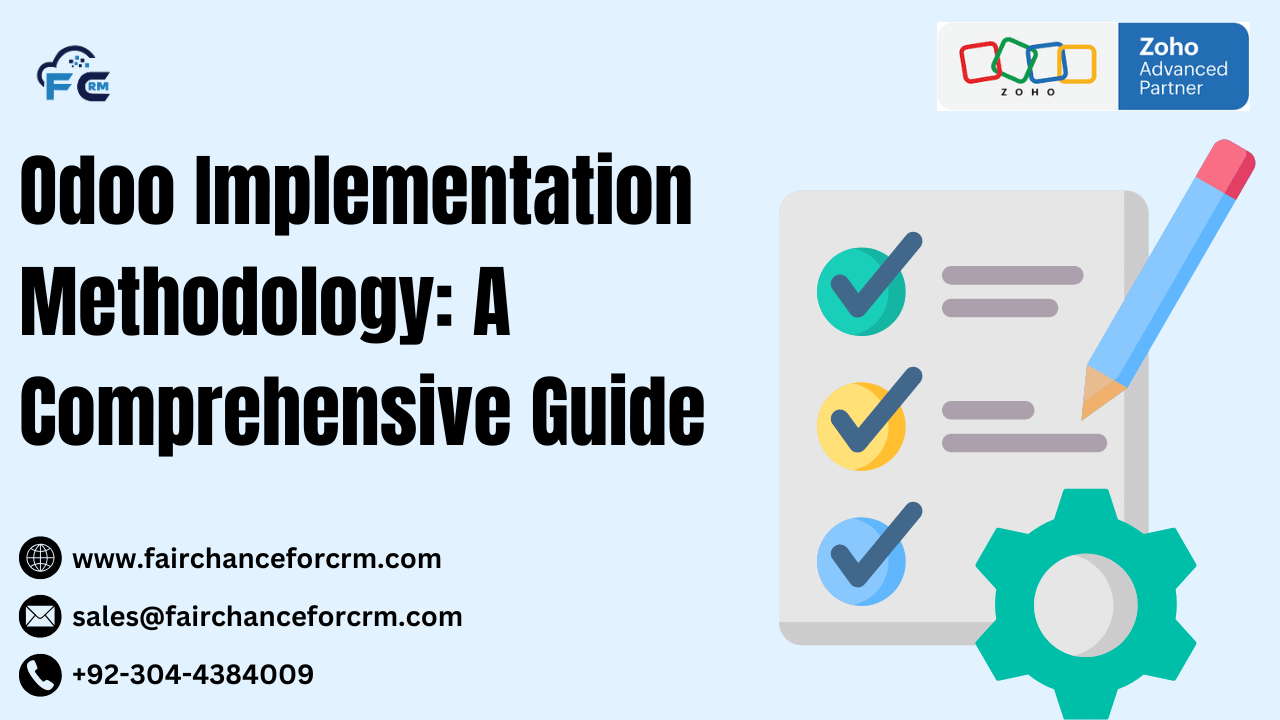Odoo Implementation Methodology is our topic. Odoo, a versatile open-source enterprise resource planning (ERP) software, is becoming an increasingly popular choice for organizations of all kinds. Odoo is known for its modularity and flexibility, allowing businesses to build only the modules they require and scale the system as they grow. However, successfully integrating Odoo involves careful planning, competent execution, and ongoing alignment with corporate goals. This article delves into the usual Odoo implementation technique, outlining the phases and critical tasks needed in ensuring a successful deployment.
Also Read:
- Automated Email Campaigns in Zoho CRM for E-Commerce Business
- 7 Reasons Zoho CRM is the Best Choice for E-Commerce
- Ecommerce Operations 101: Essentials of Running a Profitable Online Store
- The Ultimate Guide to Ecommerce Marketing | FAIRCHANCE FOR CRM
- 9 Challenges for Ecommerce Businesses and How to Improve
Odoo Implementation Methodology: A Comprehensive Guide
1. Pre-Implementation Phase: Planning and Preparation
The foundation for a successful Odoo Implementation Methodology lies in the pre-implementation phase. This phase is critical for setting the direction and preparing both the technical and business teams for the upcoming project.
a) Project Scoping and Requirements Gathering
The first step is to identify the business needs and define the scope of the project. This involves conducting workshops with stakeholders across different departments (such as finance, sales, manufacturing, and HR) to understand their pain points, processes, and goals. The objective is to map out the specific requirements that Odoo needs to address.
b) Choosing the Right Odoo Version and Modules
Odoo offers both the Community and Enterprise versions. The version you choose is determined by the complexity of your business processes, the number of users, and the requirement for sophisticated capabilities such as embedded reporting tools, workflow automation, or AI-based functionality. During this step, you must select the appropriate modules based on business needs, such as sales, accounting, inventory, CRM, and HR.
c) Team Formation and Project Governance
A dedicated project team is crucial for driving the Odoo Implementation Methodology. The team should consist of both technical (Odoo developers, consultants, project managers) and functional (business analysts, department heads) experts. Establishing clear roles, responsibilities, timelines, and communication channels ensures smooth coordination throughout the project.
2. Implementation Phase: Configuration and Customization
With a solid foundation in place, the next phase involves the actual configuration, customization, and deployment of Odoo within the organization.
a) System Configuration
The Odoo ERP system offers an extensive set of default settings, but it requires customization to meet specific business needs. During the configuration phase, key business processes such as sales order management, inventory tracking, financial accounting, and HR management are set up in Odoo.
This involves defining workflows, access control, and user roles to ensure each department can use the system according to their needs. The configuration should align with the documented business requirements and processes.
b) Customization
While Odoo’s modular nature allows businesses to tailor the system, some businesses may require custom-built functionalities that are not part of the default modules. Customization involves adapting Odoo’s codebase to integrate with existing third-party applications, adding bespoke features, or modifying existing workflows.
For example, an organization may need to create a custom report or integrate Odoo with a legacy system. Customization must be carried out by an experienced Odoo development team to avoid system conflicts or scalability issues.
c) Data Migration
Data migration is the process of transferring data from legacy systems to Odoo. It involves mapping data structures between the old and new systems and ensuring that critical business data, such as customer records, invoices, inventory levels, and employee details, are accurately migrated.
This step requires thorough planning and testing, as errors during migration can lead to data inconsistency and system failures. It’s advisable to run several migration tests before the final data migration to ensure smooth transition and minimal disruption.
3. Testing Phase: Validation and Refinement
Once the system has been configured and customized, it’s essential to rigorously test the system to validate its functionality. This phase ensures that the implementation meets the business requirements and is free from critical bugs or issues.
a) Unit Testing
Unit testing involves testing individual modules to ensure they work as expected. Each functional area—sales, inventory, accounting, and HR—should be tested independently for accuracy and reliability.
b) Integration Testing
Integration testing focuses on verifying that all modules work seamlessly together. For instance, testing the integration between the inventory module and sales module, ensuring that stock levels are updated correctly when a sales order is processed, or testing how invoices and accounting data flow from sales to finance.
c) User Acceptance Testing (UAT)
User Acceptance Testing is performed by the business users who will be operating the system. UAT is critical because it ensures that the system matches the business processes and user expectations. Users should test real-world scenarios and workflows to check if the system delivers the desired functionality and usability.
4. Deployment Phase: Go-Live
The deployment phase is where the system is officially launched and made available for use across the organization.
a) Final Preparations
Before going live, a comprehensive checklist should be reviewed, including finalizing user roles, permissions, and training schedules. Backups of all data should be taken, and the system should be optimized for performance.
b) Go-Live
The actual go-live event marks the moment when the Odoo system is switched on for full use by the organization. This is often a carefully coordinated event, with contingency plans in place in case of unforeseen issues.
During go-live, the implementation team should remain on standby to address any technical glitches or questions from users. It’s common for some minor issues to arise post-launch, and having a team ready to resolve them ensures minimal disruption.
5. Post-Implementation Phase: Support and Continuous Improvement
Once the system is live, the project doesn’t end. In fact, the post-implementation phase is where long-term success is ensured.
a) Training and Knowledge Transfer
Continuous training is crucial to ensure that users maximize the full potential of Odoo Implementation Methodology. Depending on the complexity of the system and user roles, training can range from basic functionality to advanced reporting and automation.
Knowledge transfer to internal teams ensures that they can maintain the system and troubleshoot minor issues independently, reducing reliance on external consultants.
b) Ongoing Support and Maintenance
Ongoing support includes providing troubleshooting, bug fixes, and periodic updates.This guarantees that the system is functioning, safe, and up to date when Odoo releases new versions.
c) Continuous Improvement
As businesses grow, their processes and needs evolve. Odoo’s modular design enables for the simple addition or removal of modules, making continual improvement an ongoing process. Periodic system performance assessments, feedback collecting, and tweaks guarantee that the ERP system remains aligned with the changing demands of the business.
Conclusion
Successful Odoo adoption needs meticulous planning, competent execution, and ongoing monitoring. Businesses may maximize the potential of Odoo by following a disciplined methodology that includes pre-implementation planning, system configuration, testing, deployment, and post-implementation support.
The key to success is to align Odoo’s flexibility with the company’s strategic goals while also ensuring that the solution is scalable and adaptable as the company grows.
For more information about the Odoo Implementation Methodology, visit this link.
If you want to Free Trail Zoho, click on this link.




